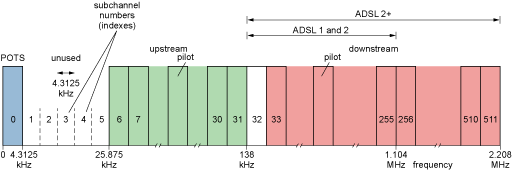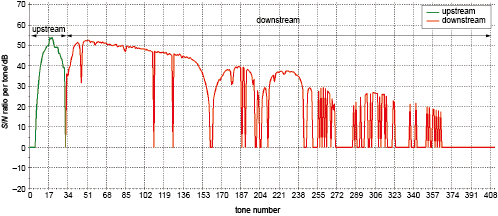4.3 Digital Subscriber Line (DSL) broadband
In DSL an ordinary telephone line (consisting of a pair of twisted copper wires) is used to deliver broadband to homes and offices. DSL uses a variant of OFDM called Discrete Multitone (or DMT). A common form of DSL is Asymmetrical DSL, or ADSL, which itself is available as ADSL1, ADSL2 and ADSL2+. Figure 4.4 shows ADSL subchannels which are numbered from zero upwards.
The subchannels in DSL are 4.3125 kHz wide. Subchannel zero is reserved for the ‘Plain Old Telephony Service’ (POTS), which is analogue telephony. Subchannels 6 to 31 are for upstream data (from the user to the telephone exchange), and subchannels from 32 upwards are for downstream data (from the exchange to the user).
Some subchannels are unused, for example subchannels 1 to 5 and 32. These provide a guard band between groups of subchannels. Other subchannels do not carry user data but are used for pilot tones required for the proper functioning of the system.
Downstream subchannels greatly outnumber upstream subchannels, hence the ‘asymmetry’ of ADSL. The downstream data rate is therefore much higher than the upstream rate.
Figure 4.5 is the signal-to-noise ratio of a 2 km long telephone line. The ‘tone numbers’ on the horizontal axis are the same as subchannel numbers. The line gets noisier at higher numbers, which almost always happens. There are places where the subchannels are so noisy as to be unusable, and this is commoner at the upper end.
Figure 4.6 shows the bit loading per subchannel, which is the number of bits per symbol per subchannel. The better, less noisy subchannels (generally at lower numbers) are loaded with more bits than are the poorer subchannels. QAM modulation is used in each subchannel, enabling the bit loading to be varied. For example, 64-QAM gives 6 bits per symbol (because 26 = 64), and 16-QAM gives 4 bits per symbol (because 24 = 16). There are 4000 symbols per second in the widely used versions of DSL, so Figure 4.6 shows the number of bits per subchannel per symbol period.
Because each telephone line has a different noise characteristic which varies over time, a ‘one size fits all’ modulation scheme,(where there is a standard order of QAM for each subchannel), would not be very efficient. OFDM, however, allows optimum use of each line because the subchannel bit loading can be automatically customised for the prevailing noise at each location. The bit loading can change as noise conditions change during the day, or from day to day.
If a particular subchannel is not loaded to its capacity, it can be topped up with bits that would otherwise have exceeded the capacity of another subchannel. This process is known as bit swapping, and is a distinguishing feature of DMT (as opposed to OFDM).
Despite the order of QAM being chosen to suit the noise conditions, errors still occur. Reed-Solomon error correction is therefore incorporated into DSL, and on particularly poor lines interleaving of data units may also be used. This increases the latency of data transmission.
Activity 4.1 Self assessment
If every downstream subchannel in ADSL2+ were loaded to 13 bits, what would be the data rate? Ignore unused subchannels.
Answer
There are 4000 symbols per second. Each symbol in each subchannel is loaded to 13 bits, so data rate per subchannel is
4000 × 13 bit s-1 = 52 kbit s–1
The highest numbered downstream subchannel is 511. The lowest is 32. The total number of subchannels is therefore 480. Therefore the overall data rate is
480 × 52 kbit s–1 = 24.96 Mbit s–1



